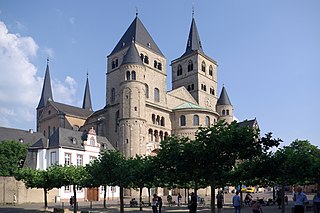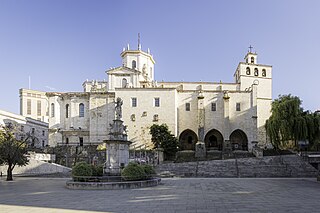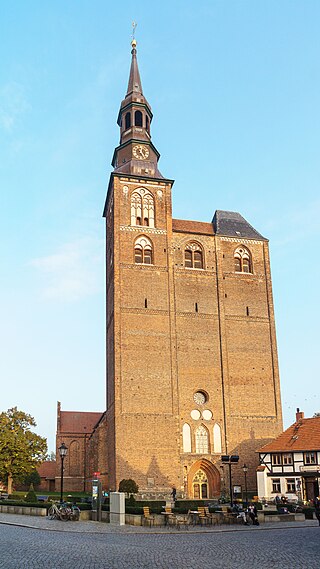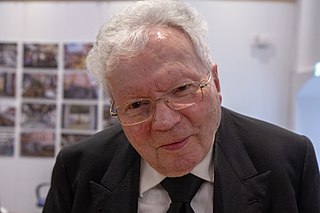
The Collegiate Church of St. Stephan, known in German as St. Stephan zu Mainz, is a Gothic hall collegiate church located in the German city of Mainz. It is known for windows created by Marc Chagall.

The Collegiate Church of St. Stephan, known in German as St. Stephan zu Mainz, is a Gothic hall collegiate church located in the German city of Mainz. It is known for windows created by Marc Chagall.
St. Stephan was originally built in 990 at the order of Archbishop Willigis, who also initiated the building of Mainz Cathedral. The church was founded on top of the highest hill in the town (in a charter of 992 by Otto III the church is described as being infra muros Mogontię in summitate eiusdem civitatis), most likely on behalf of Theophanu, the widow of Otto II. Willigis intended the church to be a site of prayer for the Empire .
The provost of the Collegiate Church administered one of the archdiaconates (a medieval organizational form similar to today's diaconates) of the Archbishopric of Mainz.
The current church building dates from the late medieval era; construction of the main area of the church began in about 1267 and was completed in 1340. The successional building kept the guidelines of the floor plan of the original Willigis building and with it the design as a double choir church. St. Stephan is the oldest Gothic hall church in the Upper Rhine district, and is (besides Mainz Cathedral) the most important church in the city of Mainz.

Only a few changes have been made to the church since the 14th century. The cloister, for instance, was added between 1462 and 1499 to the southern side of the church, and the outer face of the church was updated during the Baroque period. In 1857 a great explosion in a nearby powder magazine (Mainz was a federal fortress in the 19th century) destroyed the baroque facing of the church.
St. Stephan was heavily damaged in the cause of the bombing of Mainz in World War II. The cloister was heavily damaged and was rebuilt between 1968 and 1971; the restoration of the huge western belfry was also completed at that time, albeit with some difficulty. The arches over the nave and the choir could not be saved and have been replaced by a flat wooden ceiling.
The church features a Gothic hall with a triple nave and quires at both the west and east ends. A large octagonal bell tower rises above the western choir.

The Chagall choir windows in St. Stephan are unique in Germany. Between 1978 and his death in 1985, Belarusian Jewish artist Marc Chagall created nine stained-glass windows of scriptural figures in luminous blue. The figures depict scenes from the Old Testament, demonstrating the commonalities across Christian and Jewish traditions. Chagall intended his work to be a contribution to Jewish-German reconciliation, made all the more poignant by the fact that Chagall himself fled France under Nazi occupation. He chose St. Stephan due to his friendship with Monsignor Klaus Mayer, who was then the presiding priest of St. Stephan. Chagall's work has been continued after his death by his pupil Charles Marq and by others.
Despite the immense damage caused by both World War II and the powder explosion to St. Stephan, the 13th-century altar mensa (or table) and the huge Tabernacle dating from about 1500 have both survived.
Archbishop Willigis was buried in the church in 1011. His resting place is no longer known, but it is believed he is buried in the collegiate area.

Mainz Cathedral or St. Martin's Cathedral is located near the historical center and pedestrianized market square of the city of Mainz, Germany. This 1000-year-old Roman Catholic cathedral is the site of the episcopal see of the Bishop of Mainz.

Hildesheim Cathedral, officially the Cathedral of the Assumption of Mary or simply St. Mary's Cathedral, is a medieval Roman Catholic cathedral in the city centre of Hildesheim in Lower Saxony, Germany, that serves as the seat of the Diocese of Hildesheim. The cathedral has been on the UNESCO World Cultural Heritage list since 1985, together with the nearby St. Michael's Church because of its unique art and outstanding Romanesque architecture.

Regensburg Cathedral, also known as St. Peter's Cathedral, is an example of important Gothic architecture within the German state of Bavaria. It is a landmark for the city of Regensburg, Germany, and the seat of the Catholic Diocese of Regensburg.

The St. Thomas Church is a Lutheran church in Leipzig, Germany, located at the western part of the inner city ring road in Leipzig's central district. Martin Luther preached in the church in 1539. It is associated with several well-known composers, especially Johann Sebastian Bach, who was its Thomaskantor from 1723 until his death in 1750. The church holds his remains.

St Peter's Cathedral is a Roman Catholic church and former cathedral in Worms, southern Germany.

Speyer Cathedral, officially the Imperial Cathedral Basilica of the Assumption and St Stephen, in Latin: Domus sanctae Mariae Spirae in Speyer, Germany, is the seat of the Roman Catholic Bishop of Speyer and is suffragan to the Roman Catholic Archdiocese of Bamberg. The cathedral, which is dedicated to St. Mary, patron saint of Speyer and St. Stephen is generally known as the Kaiserdom zu Speyer. Pope Pius XI raised Speyer Cathedral to the rank of a minor basilica of the Roman Catholic Church in 1925.

Limburg Cathedral (German: Limburger Dom, also known as Georgsdom after its dedication to Saint George, is located above the old town of Limburg in Hesse, Germany. It is the cathedral of the Catholic Diocese of Limburg. Its high location on a rock above the river Lahn provides its visibility from far away. It is the result of an Early Gothic modernization of an originally Early Romanesque building and therefore shows a Romanesque-Gothic transitional style.

The High Cathedral of Saint Peter in Trier, or Trier Cathedral, is a Roman Catholic cathedral in Trier, Rhineland-Palatinate, Germany. It is the oldest cathedral in Germany and the largest religious structure in Trier, notable for its long life span and grand design. The central part of the nave was built of Roman brick in the early fourth century, resulting in a cathedral that was added onto gradually in different eras. The imposing Romanesque westwork, with four towers and an additional apse, has been copied repeatedly. The Trier Cathedral Treasury contains an important collection of Christian art. In 1986 the church was listed as a UNESCO World Heritage Site, as part of the Roman Monuments, Cathedral of St. Peter and Church of Our Lady in Trier.

Naumburg Cathedral, located in Naumburg, Germany, is the former cathedral of the Bishopric of Naumburg-Zeitz. The church building, most of which dates back to the 13th century, is a renowned landmark of the German late Romanesque and was recognised as a UNESCO World Heritage Site in 2018. The west choir with the famous donor portrait statues of the twelve cathedral founders (Stifterfiguren) and the Lettner, works of the Naumburg Master, is one of the most significant early Gothic monuments.

Merseburg Cathedral is the proto-cathedral of the former Bishopric of Merseburg in Merseburg, Germany. The mostly Gothic church is considered an artistic and historical highlight in southern Saxony-Anhalt.

Essen Minster, since 1958 also Essen Cathedral is the seat of the Roman Catholic Bishop of Essen, the "Diocese of the Ruhr", founded in 1958. The church, dedicated to Saints Cosmas and Damian and the Blessed Virgin Mary, stands on the Burgplatz in the centre of the city of Essen, Germany.

Santander Cathedral is located in the Spanish city of Santander. Its structure is mainly Gothic, although it has been extended and renovated in later times.

Münster Cathedral or St.-Paulus-Dom is the cathedral church of the Catholic Diocese of Münster in Germany, and is dedicated to Saint Paul. It is counted among the most significant church buildings in Münster and, along with the City Hall, is one of the symbols of the city.

The Cathedral of Augsburg is a Catholic cathedral in Augsburg, Bavaria, Germany, founded in the 11th century in Romanesque style, but with 14th-century Gothic additions. Together with the Basilica of St. Ulrich and Afra, it is one of the city's main attractions. It measures 113 x 40 m, and its towers are 62 m high. It is dedicated to the Visitation of Virgin Mary.

St. John's Church is located beneath Mainz Cathedral in the historical center of Mainz, Germany. This 1100-year-old church was the first episcopal see of the Bishop of Mainz. It is the oldest church in Mainz, the oldest cathedral in the Germany of today and the only preserved cathedral building from late Carolingian and early Ottonian time in Germany.

St. Stephen's Church is a Lutheran church in Tangermünde, Saxony-Anhalt, constructed in the Brick Gothic style typical of North Germany.

The church St. Peter und Alexander is a Catholic church located in Aschaffenburg, Bavaria, Germany. It is the town's oldest church, established in the 10th century, dedicated to Saint Peter and Saint Alexander. The main building was built as a Roman basilica, while other phases were built in the early Gothic style. The current structure is a cruciform basilica, reflecting a variety of styles including a Romanesque nave from the 12th century and a 15th-century tower.

The Catholic church of St. Quintin is the parish church of the oldest proven parish in the city of Mainz. Today, St. Quintin together with the cathedral community of St. Martin forms the parish of St. Martin's Cathedral and St. Quintin. Thus the cathedral priest is therefore always the priest of St. Quintin as well.

St Severus' Church in the city of Erfurt in Thuringia, Germany, is a Roman Catholic church building. It stands on the Domberg directly next to St Mary's Cathedral. As a unique architectural ensemble, both churches together form the city's landmark. Due to its unusual form, which seems to anticipate the late Gothic hall church, St Severus' Church is one of the most important Gothic buildings in Germany. The bones of the church patron Severus of Ravenna rest in an artistically very significant sarcophagus.

Klaus Mayer was a German Roman Catholic priest in the Diocese of Mainz and was an honorary citizen of Mainz.